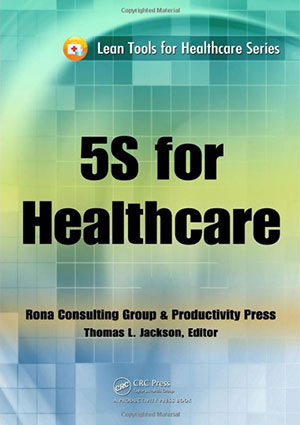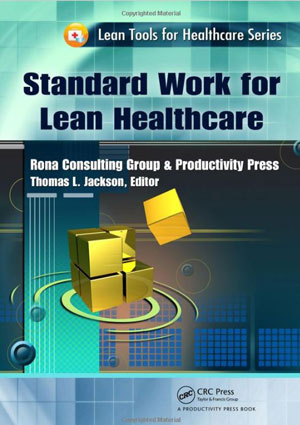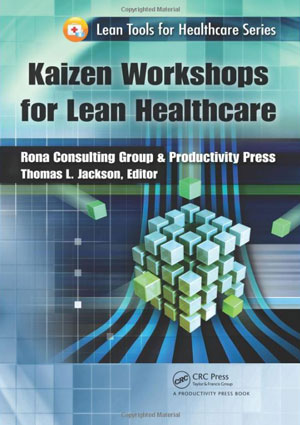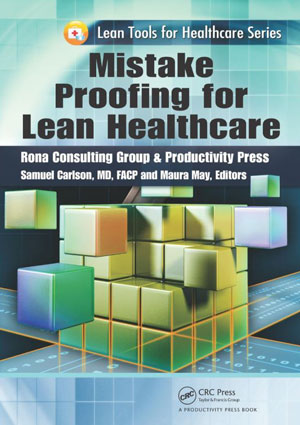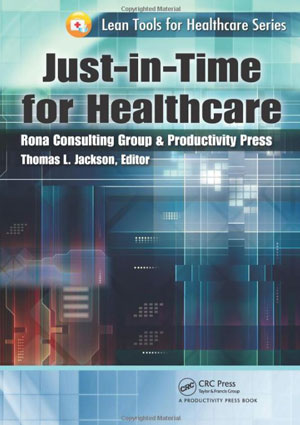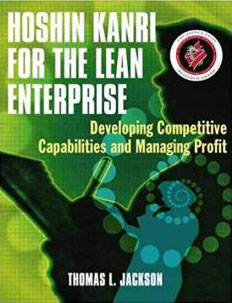Lean Tools for Healthcare Series
Transformational leaders need tools. The Lean Tools for Healthcare Series puts the classic tools of lean management in their hands, and the in hands of every frontline clinician and staff member. Based upon the Shingo-prize winning Shopfloor Series by Productivity Press, Lean Tools for Healthcare makes the teachings of Shigeo Shingo, Taiichi Ohno, and other great innovators of Japan available to the health care audience. Informed by the clinical knowledge of the Rona Consulting Group, the lean consulting practice of Moss Adams, and edited by Shingo Prize-winning Moss Adams managing director Thomas L. Jackson, these books are instructionally designed for comprehension and retention. Short, clear, and illustrated with numerous health care examples, these books are a great complement to the lean executive programs.
5S for Healthcare
Based on Hiroyuki Hirano's classic 5 Pillars of the Visual Workplace and modeled after the Shingo Prize-winning Shopfloor Series for Lean Manufacturers, 5S for Healthcare adopts a proven reader-friendly format to impart all the information needed to understand and implement this essential lean methodology. It provides examples and case studies based on the experiences of our principals, who were responsible for the groundbreaking implementation of the Toyota Production System at the Virginia Mason Medical Center.
For information on ordering this publication in bulk, click here.
Standard Work for Lean Healthcare
Proven to increase efficiencies in the manufacturing sector, standard work has become a key element in reducing process waste, ensuring patient safety, and improving health care services. Part of the Lean Tools for Healthcare Series, this reader-friendly book builds on the success of the bestselling, Standard Work for the Shopfloor.
For information on ordering this publication in bulk, click here.
Kaizen Workshops for Lean Healthcare
Kaizen Workshops for Lean Healthcare walks you through the steps of conducting an effective kaizen workshop—one that is well planned, well implemented, and well monitored. The information is presented in an easy-to-assimilate format. Numerous illustrations reinforce the text and margin assists call your attention to key terms, health care examples, and how-to steps.
For information on ordering this publication in bulk, click here.
Mapping Clinical Value Streams
Tens of thousands of patients die unnecessarily every year as a result of errors and defects in our health care processes. Those that survive often pay too much for the privilege. The value stream mapping methods described in Mapping Clinical Value Streams will help you achieve more efficient health care processes and will pave the way to an improved medical system with significantly reduced medical errors and other costly waste.
For information on ordering this publication in bulk, click here.
Mistake Proofing for Lean Healthcare
Mistake proofing is an improvement technology that uses a device or procedure, also called a poka-yoke, to prevent defects or errors during a process. Mistake proofing in health care can improve the quality of patient care and services; correct conditions in the process that allow for errors or mistakes; support ideas from knowledgeable staff to improve a process or area; and reduce costs to the organization by eliminating duplication of work. This user-friendly book introduces the concepts of Zero Quality Control (ZQC) and poka-yoke systems. Using health care examples, this practical text explains the concept of mistake proofing through the use of margin assists, key terms, and how-to-steps.
For information on ordering this publication in bulk, click here.
Just-in-Time for Healthcare
This user-friendly book is designed to improve understanding of just-in-time (JIT), a system for producing and delivering the right items to the right place at the right time in the right amounts. This text discusses why JIT is important for health care by explaining how it establishes a system of supplying service to the customer, patient, or health care provider at precisely the right time, in the correct amounts and without errors. Presented in practical terms, this book, through the use of margin assists, contains key terms and points, health care examples and how-to steps.
For information on ordering this publication in bulk, click here.
Other Books
Hoshin Kanri for the Lean Enterprise
Winner of the 2007 Shingo Prize for Research
How do you lead and manage a large workforce of people who at any moment may stop an unnecessary MRI or a wrong-side surgery in the operating room? Hoshin kanri is the answer. The lean health care organization is a different kind of animal that requires a new approach to leadership and management control. The method of hoshin kanri embodies both.
Hoshin Kanri for the Lean Enterprise, by Moss Adams Lean Health Care Practice Managing Director Thomas L. Jackson, is a practical guide to implementing hoshin kanri to improve performance in the modern business organization. As the title indicates, the book focuses on hoshin kanri, known variously as policy deployment, strategy management, and the “balanced scorecard.” Hoshin is the master control methodology, geared perfectly to the management of the radically decentralized decision-making that characterizes lean companies such as Toyota and Canon and leading health care organizations such as the Virginia Mason Medical Center and Park Nicollet Health Services.
The method works because it ensures that all managers know precisely what the company expects of them, and managers confirm their understanding by articulating exactly how they intend to support the company’s strategic goals. This commitment is crystalized in the form of a contract, called an A3.
Hoshin Kanri for the Lean Enterprise explains how to use the A3 format to document a system of commitments that aligns organizational energies around a “hoshin” or small set of significant strategic targets. The outline of the book follows the hoshin process, which is based upon the Deming cycle of Plan Do Check Act (PDCA). The book incorporates the use of value stream maps and lean accounting and includes a chapter on the often-neglected topic of the president’s diagnosis. Finally, the book explains how hoshin is related to the core lean technique of standard work.
For information on ordering this publication in bulk, click here.
The Lean Healthcare Dictionary: An Illustrated Guide to Using the Language of Lean Management in Healthcare
- Defines key lean terms and supplies examples of their use in health care.
- Describes important health care terms and relates them back to their use within a lean environment.
- Provides quick reference for anyone involved in lean implementation projects in health care.
For information on ordering this publication in bulk, click here.
